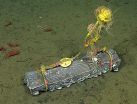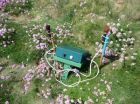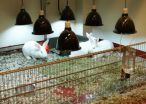(Press-News.org) A team of scientists led by the University of Bath has developed a new technique to predict the toxicity of an MRSA infection from its DNA sequence. With the MRSA superbug an increasing problem in hospitals and communities, this new technique could soon help clinicians better decide the best course of treatment for infections.
Bacterial pathogens, such as MRSA, cause disease in part due to their toxicity, or the bacterium's ability to damage a host's tissue. In a study published online today in Genome Research, researchers used the genome sequence of MRSA to predict toxicity levels for individual bacteria.
This new technique should enable clinicians to personalise treatment for individual MRSA infections.
The study looked at the whole genome sequences from 90 MRSA isolates and identified 125 genetic mutations that made an individual isolate either high or low toxicity. The researchers were surprised to find that isolates from the same clone varied hugely in toxicity.
They identified a common genetic signature shared by all the highly toxic strains. By looking for this signature, they were able to predict which isolates were the most toxic and therefore would cause severe disease.
Lead author of the study, Dr Ruth Massey from the University of Bath's Department of Biology & Biochemistry, explained: "In the future as the cost and speed of genome sequencing decreases, it will become feasible to take a swab from a patient, sequence the genome of the bacterium causing the infection, and then use this to predict the toxicity of the infection.
"Clinicians will then be able to tailor the treatment to the specific infection – this technique can tell them which combination of antibiotics will be most effective, or tell them which drugs to administer to dampen the toxicity of the infection.
"The standard approach in studying MRSA's toxicity has always been to focus on a single or small number of genes and proteins. However, this has not always been successful because toxicity is a complex trait encoded by many genetic loci. By looking at whole genome sequences we've been able to identify a number of new loci involved in toxicity.
"This work represents a step change in how genome sequencing can help us diagnose and control infections. It has also increased our understanding of how this pathogen causes severe infections by identifying novel regulators of toxicity."
Dr Mario Recker, Associate Professor in Applied Mathematics at the University of Exeter and co-author of the paper, said the research could provide pivotal insight into the virulence of MRSA. He said: "We know that many bacterial pathogens, such as MRSA, are so virulent in part because of their ability to damage a host's tissue.
"By using whole genome sequences we have been able to predict which would be most toxic, and so therefore would be more likely to cause severe disease. Having identified these novel genetic loci will also shed more light upon the complex machinery regulating bacterial virulence."
In addition to examining genomes of other MRSA strains, such as the particularly virulent USA300 clone, the authors are working to apply their methodology to other bacterial pathogens, such as Streptococcus pneumonia, a leading cause of deaths in infants and children under the age of five.
INFORMATION:
Scientists from University of Bath, University of Exeter, Dokuz Eylul University, University of Nottingham, University of Nebraska Medical Center, University of Cambridge, Wellcome Trust Sanger Institute, Emory University, and University of Gothenburg contributed to this study.
This work was supported by funding from the European Commission, the BBSRC, and a Royal Society University Research Fellowship.
To find out more about this project and help contribute, please visit http://walacea.com/
Dr Massey is available for interview today (Tuesday 8) and Thursday 10 – to arrange an interview please contact Vicky Just in the University of Bath Press Office on +44 (0)1225 386 883 or +44 (0)7966 341 357.
Dr Recker is also available for interview, to arrange please contact Duncan Sandes in the University of Exeter Press Office on +44 (0)1392 722062 or email pressoffice@exeter.ac.uk
Notes
Reference
Laabei M, Recker M, Rudkin JK, Aldeljawi M, Gulay Z, Sloan TJ, Williams P, Endres JL, Bayles KW, Fey PD, Kumar Yajjala V, Widhelm T, Hawkins E, Lewis K, Parfett S,
Scowen L, Peacock SJ, Holden M, Wilson D, Read TD, van den Elsen J, Priest NK, Feil EJ, Hurst LD, Josefsson E, Massey RC. Predicting the virulence of MRSA from its genome sequence. Genome Res doi: 10.1101/gr.165415.113
Prior to the embargo date, interested reporters may obtain copies of the manuscript via email from Peggy Calicchia, Administrative Assistant, Genome Research
(calicchi@cshl.edu, +1-516-422-4012).
University of Bath
We are one of the UK's leading universities, ranked number one in UK for student satisfaction in the 2013 National Student Survey (NSS) and in the top ten of all national league tables, including being named 'Best Campus University' in the Sunday Times Good University Guide 2014.
Our Mission is to deliver world class research and teaching, educating our graduates to become future leaders and innovators, and benefiting the wider population through our research, enterprise and influence. Our courses are innovative and interdisciplinary and we have an outstanding record of graduate employment.
View a full list of the University's press releases or follow the University's latest news on Twitter.
About the University of Exeter
The University of Exeter is a Russell Group university and in the top one percent of institutions globally. It combines world-class research with very high levels of student satisfaction. Exeter has over 18,000 students and is ranked 8th in The Times and The Sunday Times Good University Guide league table, 10th in The Complete University Guide and 12th in the Guardian University Guide 2014. In the 2008 Research Assessment Exercise (RAE) 90% of the University's research was rated as being at internationally recognised levels and 16 of its 31 subjects are ranked in the top 10, with 27 subjects ranked in the top 20. Exeter was The Sunday Times University of the Year 2012-13.
The University has invested strategically to deliver more than £350 million worth of new facilities across its campuses in the last few years; including landmark new student services centres - the Forum in Exeter and The Exchange on the Penryn Campus in Cornwall, together with world-class new facilities for Biosciences, the Business School and the Environment and Sustainability Institute. There are plans for another £330 million of investment between now and 2016.
http://www.exeter.ac.uk
Related links
Dr Massey's research profile: http://www.bath.ac.uk/bio-sci/contacts/academics/ruth_massey/
Crowdfunding project site: http://walacea.com/
DNA data could help doctors treat MRSA shows new study
2014-04-09
ELSE PRESS RELEASES FROM THIS DATE:
Stressful environments genetically affect African-American boys
2014-04-09
PRINCETON, N.J.—Stressful upbringings can leave imprints on the genes of children as young as age 9, according to a study led by Princeton University and Pennsylvania State University researchers. Such chronic stress during youth leads to physiological weathering similar to aging.
A study of 40 9-year-old black boys, published in the Proceedings of the National Academy of Sciences, shows that those who grow up in disadvantaged environments have shorter telomeres — DNA sequences that generally shrink with age — than their advantaged peers. The researchers also report ...
Bone marrow stem cells show promise in stroke treatment, UCI team finds
2014-04-09
Irvine, Calif., April 9, 2014 — Stem cells culled from bone marrow may prove beneficial in stroke recovery, scientists at UC Irvine's Sue & Bill Gross Stem Cell Research Center have learned.
In an analysis of published research, neurologist Dr. Steven Cramer and biomedical engineer Weian Zhao identified 46 studies that examined the use of mesenchymal stromal cells – a type of multipotent adult stem cells mostly processed from bone marrow – in animal models of stroke. They found MSCs to be significantly better than control therapy in 44 of the studies.
Importantly, the ...
See what a child will look like using automated age-progression software
2014-04-09
It's a guessing game parents like to ponder: What will my child look like when she grows up? A computer could now answer the question in less than a minute.
University of Washington researchers have developed software that automatically generates images of a young child's face as it ages through a lifetime. The technique is the first fully automated approach for aging babies to adults that works with variable lighting, expressions and poses.
"Aging photos of very young children from a single photo is considered the most difficult of all scenarios, so we wanted to focus ...
Sunken logs create new worlds for seafloor animals
2014-04-09
MOSS LANDING, CA — When it comes to food, most of the deep sea is a desert. Many seafloor animals feed on marine snow—the organic remnants of algae and animals that live in the sunlit surface waters, far above. However, marine snow only falls as a light dusting and doesn't have much nutritional value. Thus, any other sources of food that reach the deep sea provide a temporary feast. Even bits of dead wood, waterlogged enough to sink, can support thriving communities of specialized animals. A new paper by biologists at the National Evolutionary Synthesis Center and the Monterey ...
Scientists reconstruct ancient impact that dwarfs dinosaur-extinction blast
2014-04-09
WASHINGTON, D.C. -- Picture this: A massive asteroid almost as wide as Rhode Island and about three to five times larger than the rock thought to have wiped out the dinosaurs slams into Earth. The collision punches a crater into the planet's crust that's nearly 500 kilometers (about 300 miles) across: greater than the distance from Washington, D.C. to New York City, and up to two and a half times larger in diameter than the hole formed by the dinosaur-killing asteroid. Seismic waves bigger than any recorded earthquakes shake the planet for about half an hour at any one ...
Counting the invisible by sound -- a new approach to estimate seabird populations
2014-04-09
AUDIO:
This is a typical one minute recording of an active Cory's Shearwater colony on the island of Corvo in the North Atlantic Ocean, June 2011.
Click here for more information.
Seabirds nest in places that are inaccessible for most humans - vertical cliffs and remote islands surrounded by raging waves. Worse still, many seabirds lay their eggs in burrows or cavities where they are protected from inclement weather and invisible for researchers. Hidden under rocks or in burrows ...
Rabbits kept indoors could be vitamin D deficient
2014-04-09
CHAMPAIGN, Ill. — Rabbits that remain indoors may suffer from a lack of vitamin D, researchers report in a new study. In rabbits kept as pets or used in laboratory studies, the deficiency could lead to dental problems, undermine their cardiovascular health, weaken their immune systems and skew scientific findings.
The study found that regular exposure to artificial ultraviolet B light for two weeks doubled rabbits' serum vitamin D levels – an increase not seen in animals raised in artificial light lacking UVB radiation. Future studies will seek to determine optimal levels ...
Recycling astronaut urine for energy and drinking water
2014-04-09
On the less glamorous side of space exploration, there's the more practical problem of waste — in particular, what to do with astronaut pee. But rather than ejecting it into space, scientists are developing a new technique that can turn this waste burden into a boon by converting it into fuel and much-needed drinking water. Their report, which could also inspire new ways to treat municipal wastewater, appears in the journal ACS Sustainable Chemistry & Engineering.
Eduardo Nicolau, Carlos R. Cabrera and colleagues point out that human waste on long-term journeys into ...
Can animals really help people in hospitals, aged care?
2014-04-09
While many people have an opinion on whether animals can help to improve wellbeing and care for patients in hospitals, does anyone really know whether there are benefits both for the patients and the animals themselves?
Not according to a team of researchers from the University of Adelaide, which has conducted a worldwide review of all studies looking at the impact of "animal interventions" in healthcare settings for children.
The researchers, from the University's School of Psychology and School of Animal and Veterinary Sciences, have found that despite theories emerging ...
NASA satellite sees Tropical Depression Peipah crawling toward Philippines
2014-04-09
NASA-NOAA's Suomi NPP satellite passed over the remnants of Tropical Depression Peipah on April 9 as the storm slowly approached the Philippines from the east. According to the Joint Typhoon Warning Center, Peipah is now not expected to make landfall in eastern Visayas until April 12.
The Visible Infrared Imaging Radiometer Suite or VIIRS instrument aboard Suomi NPP captured a visible, high-resolution image of the storm as it continued moving through the Philippine Sea. The storm appeared disorganized in the image, and the center was difficult to pinpoint on the visible ...








